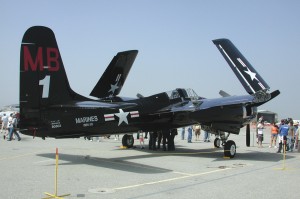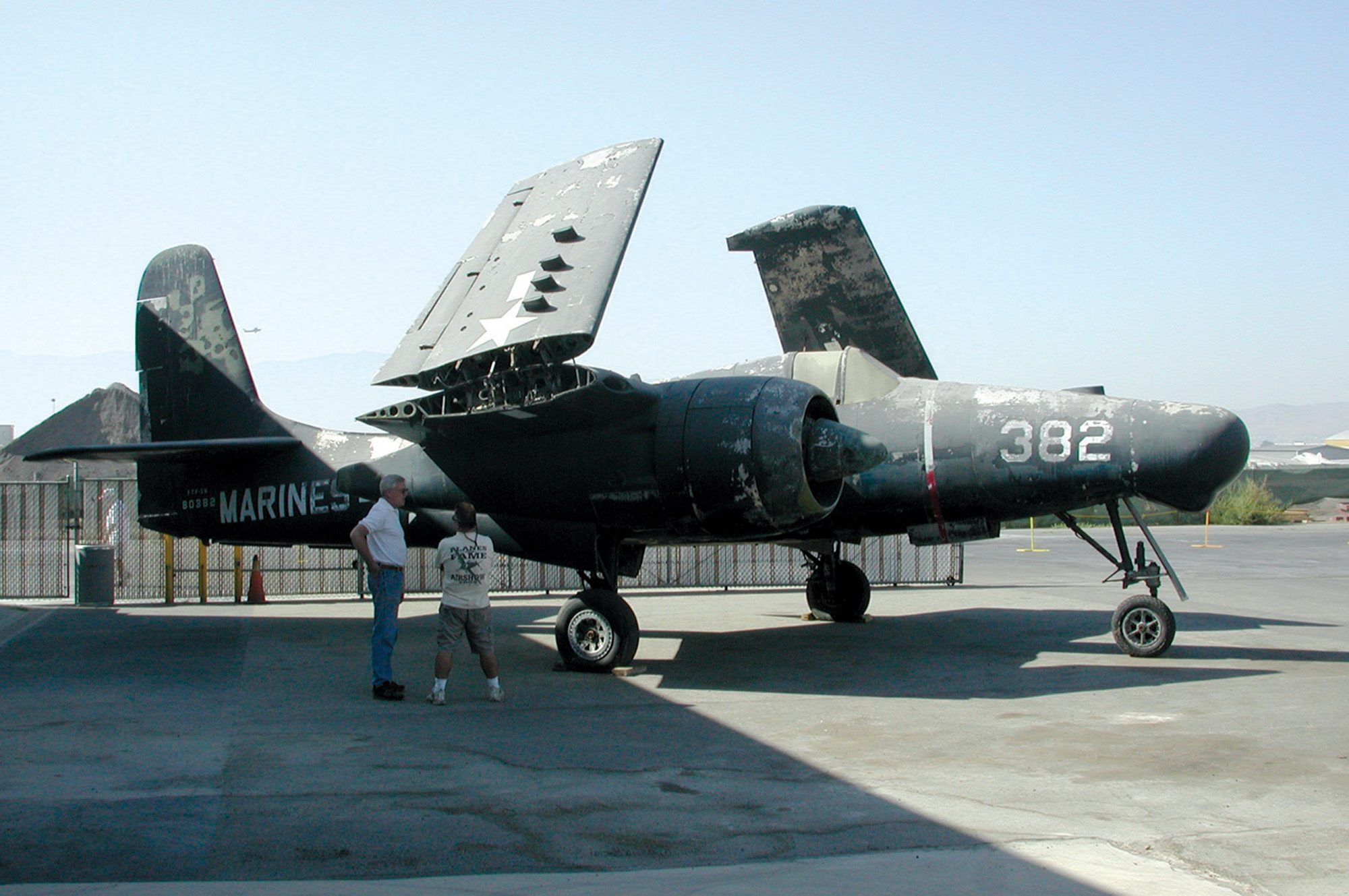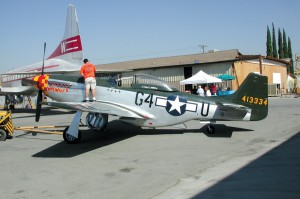By Larry W. Bledsoe

This F7F-3N Tigercat is one of the Planes of Fame aircraft awaiting restoration. A cursory inspection of the aircraft shows that there is much to be done before it will fly again.
Air show crowds love to see sleek P-51s and other fighters and bombers from World War II making low passes. The sight of these planes in the air is something to behold. Then there’s the sound. When these living memories from the past start up, even the smell of oil and spent avgas is a rich fragrance to warbird buffs.
But how long will these aircraft be able to continue to fly? This was the subject of a recent featured event at the Planes of Fame museum at Chino Airport. Since the 1970s, this airport has been the major warbird restoration center on the West Coast, but due to urban encroachment, that’s beginning to change.
Warbird restoration has changed significantly over the past 50 years. After World War II, thousands of fighter aircraft and bombers were destroyed, one way or another, as documented in W. T. Larkins’ book, “Surplus WWII U.S. Aircraft.” Many were scrapped. Not all of them were war-weary veterans; many were fresh from the factory. Trainers and liaison aircraft were the ones most often purchased by civilians, and the rest by scrap dealers. However, a few fighters survived the carnage.
One of the first planes acquired by Ed Maloney, founder of Planes of Fame, was a Japanese fighter he found in a Los Angeles junkyard. He found another Japanese plane and a prewar American fighter in other obscure locations. These planes are still part of the Planes of Fame collection, of which more than 50 have been restored to flyable condition. One of Maloney’s early acquisitions, a Boeing P-23, was recently restored and flew in the Planes of Fame air show in May.
By the 1960s, Mustangs that sold for $1,500 after the war were selling for $30,000 or more. By the 1980s, their value had increased to more than $100,000. Today, a collector might spend three to four million dollars restoring a Mustang to trophy condition.
Just what is a trophy restoration? As the cost of warbird restoration has escalated, new terms have come into use. The old fashion method of just replacing the worn out or damaged parts needed to make the plane flyable is increasingly rare.
Not all warbirds in museums or flying today are survivors of the mass destruction that followed the war. Many have been resurrected from crash sites around the world. The most notable is the P-38 Glacier Girl, which was rescued from under tons of ice in Greenland. The shear weight of the ice that encapsulated the plane crushed it flat. A new plane was created from salvageable parts.

An immaculately restored F7F Tigercat provided an awesome flight demonstration at the Chino Air Show in May. Seeing it on static display, while exciting, isn’t nearly as spectacular as seeing and hearing it in flight.
Depending on what is available, and the most expedient, a restorer will either use salvageable parts, or a new plane can be created using the manufacturer’s blueprints. Templates can also be created from other restored aircraft.
To what extent are some of these aircraft rebuilt? They may look like the real thing, and fly like it, but under that beautiful coat of paint is a patched-up old plane with new material and parts. Planes in this category are classified as simply restored aircraft and are usually survivors from World War II.
Other aircraft are carefully taken apart, and every marking, inside and out, including inspection stamps, are carefully documented and faithfully reproduced when the aircraft is reassembled. The same type of wiring is used. Authentic rebuilt instrumentation is used. These aircraft are as near to being like factory-built aircraft as possible. These are classified as “trophy” aircraft, because the owners are usually vying for the “best of show” trophy at places like EAA AirVenture Oshkosh.
Sometimes it’s less expensive to build these planes from scratch, using either blueprints or from carefully documented specifications from existing aircraft. The most current example of these replica aircraft is five Me-262s that are being built by Legend Flyers in Everett, Wash. Two of these replica aircraft have already had their first test flights.
Tony Ritzman of Aero Trader, known for their B-25 restorations, pointed out that the cost of restoration is escalating for several reasons. Age has a lot to do with it. The manufacturing processes used during the war weren’t necessarily conducive to long life of the material.
He described how the accepted manufacturing process at the time was dipping aluminum in a hot salt bath to harden the material. That worked for the short term, but now, some 60 years later, the material is corroding because of it. As a result, some castings are no longer usable. The electrical wiring and hydraulic tubing and hoses are aging to the point where they must be replaced. Fuel cells are another problem. The rubber used to make the tanks self-sealing if hit by bullets or shrapnel is deteriorating and contaminating the fuel.
Another important factor is that skills required to rebuild certain parts are rapidly disappearing. Ritzman used the control surfaces for the Corsair as an example; the surfaces are made of fabric-covered wood with metal hinges. Through usage, the wood under the hinge is compressed, so the attachment has to be tightened. Now, some 60 years later, the wood has been compressed to the point where it’s no longer usable. He said the skill needed to build a new part is almost a lost art.
Restorers face similar situations with other components used on the planes. Services such as prop shops and engine rebuilding are also getting more expensive due to the dwindling supply of parts, and people with the skills required to do the job.
Ritzman pointed out that Aero Trader has a large inventory of spare parts for B-25s—enough to last them for decades. But the availability of spare parts to rebuild other warbirds is rapidly dwindling. This is partly due to the fact that warbird rebuilding is a growing worldwide business, creating more competition for the limited supply of parts available. He mentioned a supplier who had a huge inventory; when he died, that inventory was auctioned off. Unfortunately, scrap dealers were able to outbid the collectors who needed the parts.
Another example of a diminishing supply is World War II instrumentation. Many of the instruments had radium dials that glowed in the dark. Now, the government prohibits instrument shops from repairing them.
Today, the acquisition of an aircraft is only about a third of the commitment, which includes crew training, maintenance, fuel, oil and insurance. A set of tires for a B-25 runs about $7,000 and is good for about 150 landings. It now costs about $1,500 an hour to operate a B-25.
So, will warbirds still be flying in the year 2099? The answer is maybe. Warbird restoration and replica aircraft manufacturing is now a global industry that is growing. The documentation needed to build these aircraft from scratch does exist. The skills needed can be learned or passed on to future generations. New tooling can be made to replace what has been worn out, lost or destroyed.
Some argue that the best way to preserve these aircraft for future generations is to restore them and display them in museums, and not fly them. Their argument is that a few restored warbirds that are flown have crashed. They admit that although this is rare, it does happen.
Noted aviation photographer Frank Mormillo, who was moderator for this event, said that more warbirds have been lost due to museum fires, hurricanes or other natural disasters than due to flying accidents. Many of the warbirds flying today are rebuilt from crashed aircraft.
Yes, the capability of keeping warbirds flying for decades to come is there. It may not be the same plane, or even part of one of the planes built in the 1940s, but for all intents and purposes, it will look and fly like a factory-fresh aircraft off any Douglas, Boeing or North American assembly line. Flying is what planes are built to do, and keeping them flying is what most aviation buffs want to do. The catch, however, is skyrocketing insurance cost, government interference, and misguided people who just don’t understand the love some of us have for these wonderful flying machines.












